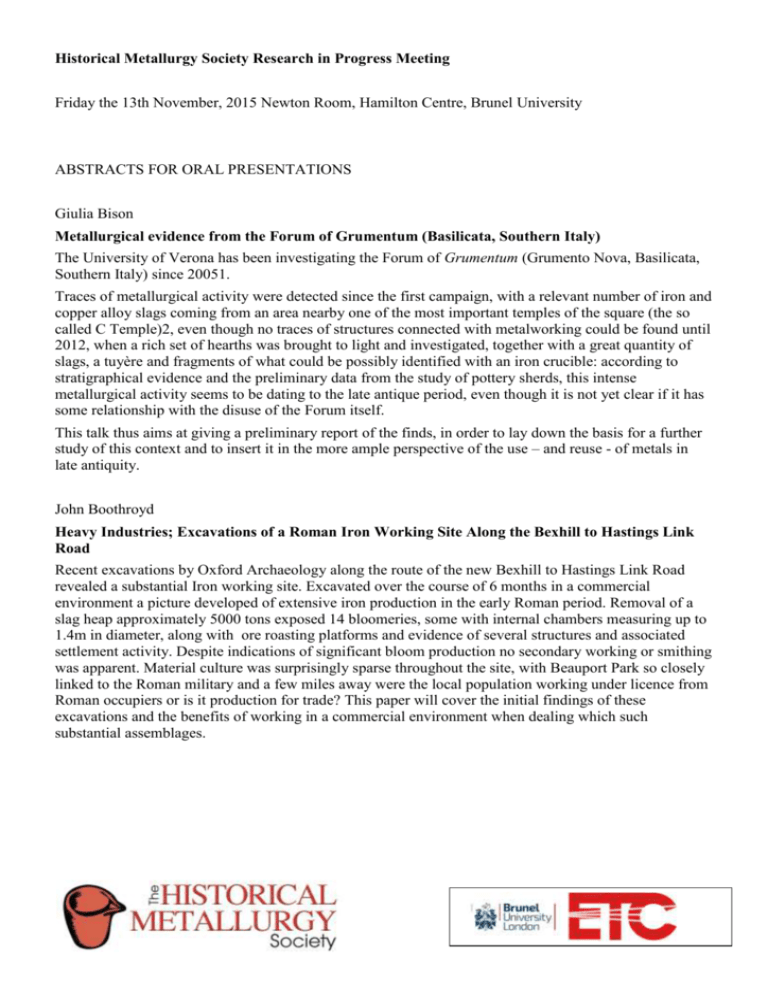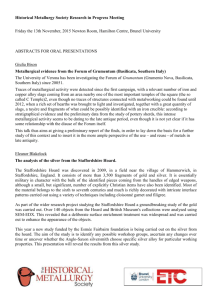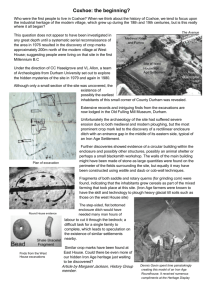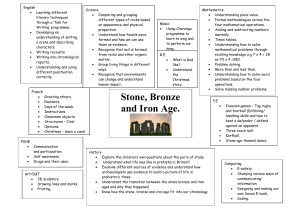Here - Historical Metallurgy Society
advertisement

Historical Metallurgy Society Research in Progress Meeting Friday the 13th November, 2015 Newton Room, Hamilton Centre, Brunel University ABSTRACTS FOR ORAL PRESENTATIONS Giulia Bison Metallurgical evidence from the Forum of Grumentum (Basilicata, Southern Italy) The University of Verona has been investigating the Forum of Grumentum (Grumento Nova, Basilicata, Southern Italy) since 20051. Traces of metallurgical activity were detected since the first campaign, with a relevant number of iron and copper alloy slags coming from an area nearby one of the most important temples of the square (the so called C Temple)2, even though no traces of structures connected with metalworking could be found until 2012, when a rich set of hearths was brought to light and investigated, together with a great quantity of slags, a tuyère and fragments of what could be possibly identified with an iron crucible: according to stratigraphical evidence and the preliminary data from the study of pottery sherds, this intense metallurgical activity seems to be dating to the late antique period, even though it is not yet clear if it has some relationship with the disuse of the Forum itself. This talk thus aims at giving a preliminary report of the finds, in order to lay down the basis for a further study of this context and to insert it in the more ample perspective of the use – and reuse - of metals in late antiquity. John Boothroyd Heavy Industries; Excavations of a Roman Iron Working Site Along the Bexhill to Hastings Link Road Recent excavations by Oxford Archaeology along the route of the new Bexhill to Hastings Link Road revealed a substantial Iron working site. Excavated over the course of 6 months in a commercial environment a picture developed of extensive iron production in the early Roman period. Removal of a slag heap approximately 5000 tons exposed 14 bloomeries, some with internal chambers measuring up to 1.4m in diameter, along with ore roasting platforms and evidence of several structures and associated settlement activity. Despite indications of significant bloom production no secondary working or smithing was apparent. Material culture was surprisingly sparse throughout the site, with Beauport Park so closely linked to the Roman military and a few miles away were the local population working under licence from Roman occupiers or is it production for trade? This paper will cover the initial findings of these excavations and the benefits of working in a commercial environment when dealing which such substantial assemblages. Michael F Charlton Mapping the chemical diversity of iron smelting slag in Britain—new data from the IRONWORKS project The compositional diversity of iron smelting slag reflects the underlying variability in resource usage (ore, technical ceramic and fuel ash) and socially learned technological practice. The identification of slag compositional patterns offer one means of sourcing iron artefacts, assuming that the same patterns can be identified in slag inclusions. While various methods have been proposed for iron provenance via slag inclusion analysis, a robust compositional database of slag chemistry has been slow to develop. The IRONWORKS project seeks to build on previous studies of variation in British bloomery slag chemistry by increasing the range of minor and trace elements analysed via ICP-AES/MS and characterizing chemical structure with multivariate methods. Results are presented in the form of geochemical provenance maps at both site and regional scales. This paper reviews the methods being developed by the IRONWORKS project and presents its most recent results. David Cranstone Finery Steelmaking in Britain, 1560s-c1700 According to the conventional view, finery-process steelmaking (the partial decarburisation of cast iron) was of very limited importance in Britain, the only clearly-documented example being Henry Sidney’s steelworks at Robertsbridge and Boxhurst in Sussex from 1566 to 1572; cementation (the recarburisation of wrought iron) was introduced in 1614 and adapted to coal fuel by Sir Basil Brooke c 1617, and it has been assumed that this was the dominant process from then on. Current research by the author and Peter King indicates that Sidney’s patent was taken over in 1582 by Gilbert Talbot, Earl of Shrewsbury, who ran a successful finery-process steel industry until at least 1609 around the Forest of Dean supplying the London and Sheffield markets from steelworks at Huntley (documented in 1586), Linton (documented c 1604) and perhaps Flanesford (from archaeological evidence). The later history of finery steelmaking remains unclear, but a steelworks at Elmbridge, Newent (close to Linton) which operated from the 1660s to the 1680s was almost certainly using the finery process - this suggests that cementation may not have become dominant until perhaps the 1680s. Patrick Cropper Home is where the hearth is? Defining metallurgical contexts in Prehistoric Britain There is a notable lack of evidence of copper production from looking at ores, in prehistoric England, compared to continental studies in which it is readily evident. Unambiguous evidence for hearths used for copper production, has not been found. Through Desk-Based Assessment and a program of experiment, the potential evidence for British Bronze Age copper production was investigated. The experimental program consisted of the creation of three hearths that were each used for metallurgical practice. The hearths were then visually observed and analysed using X-Ray Fluorescence (XRF) in order to measure relative levels of copper. The experiments revealed that a furnace lining does not necessarily have to be vitrified in order to be indicative of metallurgical practice, prompting a need for a review of known Bronze Age production centres. The experiments also showed that use of an XRF on excavations in the future, would greatly aid in the identification of smelting sites. Several previously excavated Bronze Age sites were examined with respect to the experimental results, and it appears that there are one of two hypotheses to explain the current lack of evidence: either primary production diminished after the Early Bronze Age as several mines shut down, or by the Late Bronze Age, primary production took place on the same equipment, as was used for secondary. Also that the current criteria of identification has lead to an obfuscation of this evidence. A potential framework is also offered for future studies into this area. Costanza Cucini Tizzoni & Maria Pia Riccardi A bronze smelting laboratory and brass and mirror production in the 1st and 2nd century Mediolanum – Milan (Italy) Present day Corso di Porta Romana in Milan was the south-eastern suburbium of the roman town close to the road leading to Rome. Being a multifunctional area here there were good quality private houses, necropolises and work-shops. During recent archaeological excavations in Corso di Porta Romana 20, new and interesting data about metallurgical production in Milan have been discovered. Here the remains of a metallurgical work-shop were found. Amongst the finds there are cooking pots turned crucibles by the application of a thick layer of clay on their outer surface, clay moulds and scraps of a copper and zinc alloy. This brass was made and used for the casting of small objects and furniture appliques. The zinc ore reached Milan from the once rich deposits in Riso Valley (Bergamo) which are quoted by Plinius the Elder. The find of clay moulds for rectangular and round mirrors and of a peculiar type of cruciblemoulds has allowed the Authors to understand the technology used. It can be compared with the technology still in use in Southern India (Kerala) for the making of the Aranmula mirrors. Recent archaeological excavations in Kerala have shown that there was an intense trade between this region and Rome. Since zinc oxide making in 1st century AD Milan was quite similar to the traditional Indian process, long distance technological exchanges are suggested. It is the first find of a brass making roman laboratory in Italy and the first mirrors making site in Northern Italy. References A. CERESA MORI, C. CUCINI, un’officina di bronzista e la produzione di ottone e di specchi a Mediolanum nel I-II seolo d. C. in C. CUCINI (ed.), Acta mineraria et metallurgica. Studi in onore di Marco Tizzoni, Notizie Archeologiche Bergomensi 20, 2012, pp. 205-224. Elisa Grassi A smithy for the gods The roman Capitolium – the temple dedicated to the sacred triad formed by Jove, Juno and Minerva – of Brescia is one of the most remarkable archaeological sites of northern Italy. Although its rediscovery dates back to 1823, excavations are still in progress, and keep disclosing new and surprising parts of the site’s history. Among these, the most recent campaigns have brought to light significant evidence of the construction of the 2nd phase of the sanctuary, including the remains of a smithy where, presumably, tools and fixtures for the building site were made and repaired. Alongside the layout of the workshop and the metalworking debris – slags, furnace walls and tuyeres – a few of the smithy’s products have been retrieved in the excavations, mainly stonecutters’ chisels, which are of interest not only for archaeometallurgists, but shed light on the technical aspects of the construction of such an imposing monument. An overview of the workshop and of its finds have been recently carried out by the author within the comprehensive publication of the excavations (E. Grassi, L’officina di forgia, in Un Luogo per gli dei. L’area del Capitolium a Brescia, F. Rossi ed., Firenze 2014, pp. 195-198): now, the working space and the tools will be presented in a more detailed way. William Hawkes XXXX “Protection of the historical metal objects we research is often an overlooked consideration. However my current project is looking at the etching effect of acidified thiourea as opposed to saponin, in the cleaning of sterling silver. The investigation compares the effects of the two reagents on the surface of sterling silver, in order to make a comparison the two methods of cleaning. The results of the cleaning treatments will be taken and assessed with the use of high power microscopy to give a visual representation of the surface that results from treatment in both instances. This surface will be assessed with the use of Photoshop, in a controlled manner to establish a quantification of the etched area of the resultant surfaces. The resulting solutions of the treatments will be analysed using x-ray flouroscopy to try to understand which treatment might remove the most original material and therefore be the most detrimental. This process will be conducted with repeated treatments and evidence accrued from each stage or iteration of treatment. Relating to the evidence obtained, the dissertation will discuss the effects of the treatments, and the ramifications of each, what this means to us as metallurgical conservators, and of course to the objects themselves. Finally the project will conclude with discussion on the practicality of the treatments and what impact the treatments will have on the ability of conservators and the general public alike, to be able to reasonably employ each of the treatments.” Peter King The zenith of puddled iron and the transition steel: new estimates The invention of the Bessemer and then Open Hearth processes in the late 1850s and late 1860s respectively, followed later by basic versions of each, greatly changed the ferrous industry. Nevertheless, the transition from puddled iron to mild steel was not immediate. A lack of output data on puddling until 1881, but data on the number of puddling furnaces indicates that the zenith of puddling was in the early 1870s. However this was followed by a rapid decline in puddling in the late 1870s, as malleable iron was replaced by steel, first for rails and then in the 1880s for shipbuilding. New estimates for all processes are made. Vasco La Salvia in collaboration with Marco Valenti and Stefano Bertoldi (University of Siena), Vittorio Fronza and Manuele Putti (University of Siena) and Lorna Anguilano (Brunel University) Medieval Metallurgical activities in the Centre and South of Italy This paper will report the findings of three sites in the Centre and South of Italy: Ironmaking in southern Italy: the case of the Byzantyne kastron of Bova, a preliminary report. During the excavations inside the Byzantine kastron of Bova, in Calabria, southern Italy, evidence was found of iron making activity dating to the AD 9th-10th cent. A smithy workshop was located within the castle walls together with numerous slags indicating the principal production being the manufacturing of iron. Written sources as well shed light on the organization of production. Dismantling ancient townscape: metal production at S Cristina in Caio (Buonconvento, Siena). After the closure of the public baths, during theAD 5th, the entire settlement underwent a complete restructuring. The main feature of this was the systematic re-use (spolia) of all the material from the public building, including metals. Iron production and settlements strategy: the castle of Miranduolo between AD 7th-8th cents. The settlement of Miranduolo is heavily characterized by ironmaking activities. Evidence has been found of both mining and reduction. A system of mining pits is actually surrounding the village. Moreover, within the settlement there were clearly individuated different areas specifically dedicated to iron production. Very important is also the AD 8th smithy workshop which apparently look like a real small district. A preliminary note on the archaeometry of slag would also be given. Yvette A. Marks The Itinerant smith’s role within the early transmission of Metallurgy The early transmission of metallurgy across Eurasia, has not only been the focus of numerous studies throughout the past century, but also reigns dominant within metallurgical studies of the Late Neolithic and Bronze Age. One of the most widely-adopted and accepted models for this transmission, is that of ‘diffusionism’, which became so widely accepted due to Childe’s support of this theory from the early 20th century (Childe, 1930, 1944). Despite a contrary theory, that of the ‘loclalization theory’ being proposed, with its origin arising from the development of ground breaking developments in material science, including the application of radiocarbon dating methods to archaeological material, combined with Renfrew’s eagerness to argue from a systems perspective (Renfrew, 1973). A number of scholars over the past five decades and within current ongoing research, still favour the model of diffusionism. This paper takes an in depth look at the diffusionst theory and the role of the itinerant smith at its core, discussing how such a model would have worked during the late Neolithic and Early Bronze Age periods and within such societies. As well as going back to the roots of the model and understanding where the idea of the ‘itinerant smith’ originates from and how it was adopted to the transmission of metallurgy. This paper aims, by opening up this model and discussing how the idea of diffusionsim is believed to have taken place, we can consider its plausibility with a clearer understanding. Marta Matosz & Julio M. del Hoyo-Meléndez Medieval Polish coinage: Analysis of silver denarii minted by the early Piasts X-ray fluorescence (XRF) analyses have become a standard method in cultural heritage science due to their non-invasive and non-destructive nature. Chemical analyses of metal alloy collections provide information about the manufacturing process, the provenance of raw materials, and the geographical distribution of ancient mints. A total of 110 silver denarii from the early Piasts (10-11th centuries AD) belonging to the collections of the National Museum in Krakow and the National Museums Berlin have been characterized using micro-X-ray fluorescence spectrometry and the results have been evaluated in the context of literature data. The research has focused on evaluating the use of this technique as a screening tool for elemental surface characterization of the alloys. All denarii are made of Ag and Cu, with minor amounts of Pb, Fe, Au, Bi, and Zn. Semi-quantitative analyses have revealed silver contents in the 86-97 % range for several of the surveyed coins. In spite of the problems associated with the use of different instruments and various experimental conditions, the results are in agreement with previous data obtained for similar coins from the same time period and geographical location. In addition, the advantages and limitations of the technique when examining numismatic collections are explained. A known drawback of this method is silver surface enrichment, which is a common process observed in archaeological silver-copper alloys sometimes leading to incorrect interpretation of the data. Preliminary data from complementary techniques like neutron activation analysis (NAA) and proton-induced X-ray emission (PIXE) is very promising in accounting for some of these surface effects. This study has the goal of providing elemental information, which will serve to enhance the current knowledge about geographical and chronological diversification of Polish numismatic collections. Samantha Rowe Metal artefact decay in UK topsoils The decay of metals in soils has been studied for several decades. However, in recent years the acceleration of artefact decay in plough soils has been identified as an issue. The reason behind this acceleration is not well understood though research has identified connections between the decay of metallic archaeological artefacts and the acidification of soils, as well as agricultural activities on sites. Artefacts in plough soils are particularly vulnerable to acts of decay as they are more exposed to the elements, erosion, and human and animal activities. The condition of artefacts can vary greatly across sites both horizontally and vertically in the soil column. My research highlights the dangers artefacts face in unstratified contexts and aims to map the condition of metal artefacts in topsoils in agricultural settings. One site type particularly vulnerable to this type of deterioration is battlefields where a large proportion of historic evidence survives in the form of artefact scatters in the topsoil. I will use case studies to assess whether there is a positive correlation between the corrosion of artefacts and their burial contexts. Studying the relationship between metallic artefacts and their burial environments will help to understand the reason behind what causes metal objects to decay and which objects may be more vulnerable in particular environments. In future it is a hope that an effective strategy can be established to manage and monitor buried archaeological material on sites in England. David Sables The monks who mined This paper is an interim report on research being carried out on mining remains found on the lands of the former Cistercian Abbey of Strata Florida. Strata Florida Abbey is situated in mid Ceredigion 18 miles south of Aberystwyth and 40 miles north of Carmarthen, close to the present day village of Pontrhydfendigaid. The research project is aimed at investigating the possibility that mining may have taken place on the home grange of Strata Florida Abbey before the 18th century and that some vestige of this mining may have survived in the modern landscape. The research includes a study of both historic documentation and a detailed archaeological survey and an excavation of several features on a mining site. The paper will outline the approach taken to the research and problems encountered and the results of the research to date. Sayed Wahid Alam & Lorna Anguilano Where are the mines? Evidences of iron sources in Apulia, Italy In the past decade the work of the department of Archaeology of the Apulian Universities has uncovered a large quantity of medium to small iron production and iron working sites. From the site of La Faragola, in Ascoli Satriano where also copper and copper alloys were re-worked to the site of Salice Salentino and Giuggianello. More sites were identified by Dr Anguilano during a survey in different areas of the region. The sites are dated largely to the Middle Ages, from the 5th to the 16th century, and some of them have only been identified by finding in the top soils. However, it is very visible that iron working was largely diffused. But where are the mines. Prof. Giardino indicated the possibility that bauxitic earths could be also a source of iron. Dr Anguilano sampled a variety of bauxitic deposits, some small outcrops in the vicinity of the archaeological sites, some large quarries used for the extraction of aluminium until after WWII. This paper will present the preliminary data obtained for this study. Alan Williams & David Edge Non-invasive techniques for the analysis of swords While the metallography of plate armour is relatively straightforward, such examination of swords in museums, which are not in excavated condition, presents considerable difficulties. With colleagues from the Museo Stibbert in Florence we have been investigating the employment of neutron diffraction as a technique for analysing swords. The carbon content of steel may be deduced from the proportions of different phases, and the anisotropy of these phases may supply further information.







